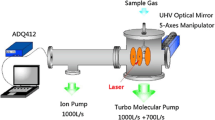Abstract.
We present calculated results for the optimization highly-charged fragment ion formation in the Coulomb explosion of I2 in an intense laser field. Calculations are performed using a simple genetic algorithm and a classical model for the Coulomb explosion process. We find that at low intensity the production of highly-charged fragment ions is optimized by a Fourier-limited pulse, whereas at higher intensity the Coulomb explosion is optimized by a sequence of pulses, with a time-separation determined by enhanced ionization at the critical internuclear distance. Our calculations provide insight into the sensitivity of adaptive pulse shaping experiments to the parameters and evolutionary approaches used.
Similar content being viewed by others
References
A.H. Zewail, J. Phys. Chem. A 104, 5660 (2000), and references therein
R.S. Judson, H. Rabitz, Phys. Rev. Lett. 68, 1500 (1992)
A. Assion, T. Baumert, M. Bergt, T. Brixner, B. Kiefer, V. Seyfried, M. Strehle, G. Gerber, Science 282, 919 (1998)
D.E. Goldberg, Genetic Algorithms in search, optimization and machine learning (Addison-Wesley, 1989)
D. Beasley, D.R. Bull, R.R. Martin, Univers. Comp. 15, 58 (1993)
J.H. Posthumus, A.J. Giles, M.R. Thompson, W. Shaikh, A.J. Langley, L.J. Frasinski, K. Codling, J. Phys. B 29, L525 (1996)
E. Constant, H. Stapelfeldt, P.B. Corkum, Phys. Rev. Lett. 76, 4140 (1996)
T. Seideman, M.Yu. Ivanov, P.B. Corkum, Phys. Rev. Lett. 75, 2819 (1995)
F. Rosca-Pruna, E. Springate, H.L. Offerhaus, M. Krishnamurthy, C. Nicole, N. Farid, M.J.J. Vrakking, J. Phys. B 34, 4919 (2001)
S. Banerjee, D. Mathur, G. Ravindra Kumar, Phys. Rev. A 63, 045401 (2001)
E. Springate, F. Rosca-Pruna, H.L. Offerhaus, M. Krishnamurthy, M.J.J. Vrakking, J. Phys. B 34, 4939 (2001)
M.V. Ammosov, N.B. Delone, V.P. Krainov, Sov. Phys. JETP 91, 1191 (1986)
A.M. Weiner, Rev. Sci. Instrum. 71, 1929 (2000)
D. Zeidler, S. Frey, K.-L. Kompa, M. Motzkus, Phys. Rev. A 64, 023420 (2001)
These optimum parameters were found in test calculations, where a fitness function was defined directly based on the time dependence of the laser pulse. This fitness function consisted of a superpostion of an autocorrelation term and a convolution term, similar to the dependence of the fitness function on the structure of the laser pulse in the Coulomb explosion calculation
Author information
Authors and Affiliations
Corresponding author
Additional information
Received: 6 January 2003, Published online: 15 July 2003
PACS:
33.80.Rv Multiphoton ionization and excitation to highly excited states (e.g., Rydberg states) - 82.53.Eb Pump probe studies of photodissociation - 02.60.Pn Numerical optimization
Rights and permissions
About this article
Cite this article
Vrakking, M.J.J. Control of the Coulomb explosion of I2 . Eur. Phys. J. D 26, 111–118 (2003). https://doi.org/10.1140/epjd/e2003-00203-9
Issue Date:
DOI: https://doi.org/10.1140/epjd/e2003-00203-9




